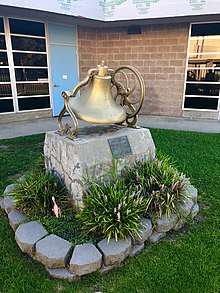Timber School
| Timber School House | |
|---|---|
 The original Timber School in the 1890s | |
| General information | |
| Architectural style | Mission Revival (current schoolhouse) |
| Location | 1872 Newbury Road, Newbury Park, CA |
| Completed | 1889 and 1924 |
| Owner | Daylight Thousand Oaks LLC[1] |
| Design and construction | |
| Architect | Roy C. Wilson |
The Timber School was the first school in Newbury Park, California when established in 1889.[2][3] and the current 1924 reconstructed Timber School is the oldest remaining school in the City of Thousand Oaks.[4] It is also the oldest remaining public building in the Conejo Valley.[5][6]
The original Timber School was demolished in 1925, but the current building had already been erected a year before immediately in front of the old site. The current Timber School House was designed in Mission Revival architectural style by Roy C. Wilson, Ventura County’s first licensed architect. It is located at the current site of Conejo Valley High School, at the southeast corner of Kelley- and Newbury Roads. It is City of Thousand Oaks Landmark No. 12, along with the nearby 1948 Auditorium.[5][6] It is Ventura County Historical Landmark No. 166.[7][8]
The original 19th century bell tower can still be seen at its original site, while the bell itself is placed on a monument stand at Cypress Elementary School.[9][10] An authentic replica of the 1888 schoolhouse is located next to the Stagecoach Inn, along with a replica of the 13-inch high bell.[11]
Notable former students include Reba Hays Jeffries, H. Allen Hays, Adolph Friedrich Jr., Ed Borchard Jr., Donald Haigh, Casper Borchard Jr., Simon Hays, Fred Kelley, Oscar Olsen, and Florence Hampton.[7]
History

Until its establishment in 1889, students of Timberville (now Newbury Park) had been attending classes at the Grand Union Hotel, which was located a few hundred yards east from the schoolhouse.[12] The school drew its student body mainly from Newbury Park farms, and children reached the school on foot, horseback or by wagon.[12][13] It was originally constructed on land which belonged to Cecil Arthur Entwisle Haigh, the owner of the Grand Union Hotel.[12] In December 1888, Haigh sold two acres of his land for a new school, at the present day corner of Kelley- and Newbury Roads. The school had one large classroom and two smaller rooms used as cloakrooms. The school was equipped with slate blackboards and coal oil lamps. The schoolhouse was also used for church services. A wood stove provided heat.[7] Miss Moster, the school’s first teacher, taught approximately 35 students and was paid $40 per month.[14]
Besides for educational purposes and church services, the school was also used for May Day celebrations, wedding ceremonies, and picnics. The original school was condemned in 1921, and the Timber School Board of Trustees searched for funds to construct a bigger schoolhouse. Distinguished architect Roy C. Wilson of Santa Paula was selected to design the new structure. The new school, constructed in concrete, was completed in the fall of 1924. The original Timber School, located right behind the new one, was demolished and sold as lumber in 1925. As the population of the valley continued to grow, additional classrooms were needed and an auditorium was constructed in 1949. In July 1974, Timber School District joined with nearby school districts to form the Conejo Valley Unified School District. The Timber School has been used for district offices and later the Conejo Valley Continuation School. On July 13, 2004, the Thousand Oaks City Council voted unanimously to make the Timber School City Landmark No. 12. A replica of the original 1889 school was completed in 1994 and is located at the grounds of the Stagecoach Inn Museum.[7][15]
See also
Sources
- ↑ https://www.toacorn.com/articles/plans-emerge-for-historic-timber-school-site/
- ↑ https://www.vcstar.com/story/news/local/communities/conejo-valley/2018/08/07/historic-vandalized-timber-school-newbury-park-being-boarded-up/810454002/
- ↑ http://bosagenda.countyofventura.org/sirepub/cache/2/z3d33lna4ibfpbsebbksbpoh/98551807172018113448743.PDF
- ↑ http://articles.latimes.com/2004/jun/29/local/me-timber29
- 1 2 Sprankling, Miriam and Ruthanne Begun (2006). Historical Tour of the Conejo Valley. Conejo Valley Historical Society. Page 7. ISBN 0-9725233-4-0.
- 1 2 http://www.toaks.org/departments/city-manager-s-office/public-information-office/history
- 1 2 3 4 Sprankling, Miriam and Ruthanne Begun (2012). Tales and Voices of the Conejo. Newbury Park, CA: Conejo Valley Historical Society. Page 79, 81-83. ISBN 0-9725233-6-7.
- ↑ https://docs.vcrma.org/images/pdf/planning/programs/chb/Points_of_Interest.pdf (Page 50).
- ↑ Needham, Beth (1990). Newbury Park. Thousand Oaks, CA: Beth Needham. Page 12.
- ↑ Fargo, Donna (1983). Conejo Valley Days: A Brief History of the Golden Conejo. Thousand Oaks, CA: Farland Enterprises. Page 16.
- ↑ http://articles.latimes.com/1990-10-30/local/me-3703_1_newbury-park
- 1 2 3 Bidwell, Carol A. (1989). The Conejo Valley: Old and New Frontiers. Windsor Publications. Pages 28,32,34 and 65. ISBN 9780897812993.
- ↑ O’Brien, Tricia (2017). Thousand Oaks and Westlake Village (Images of America). Arcadia Publishing. Page 16. ISBN 9781439661956.
- ↑ Sprankling, Miriam (2002). Discovering the Story of The Conejo Valley. Newbury Park, CA: Conejo Valley Historical Society. Page 57. ISBN 0-9725233-0-8.
- ↑ Begun, Ruthanne and Miriam Sprankling (2004). A Visit to the Historic Stagecoach Inn Museum. Newbury Park, CA: Conejo Valley Historical Society. Page 10. ISBN 0-9725233-2-4.